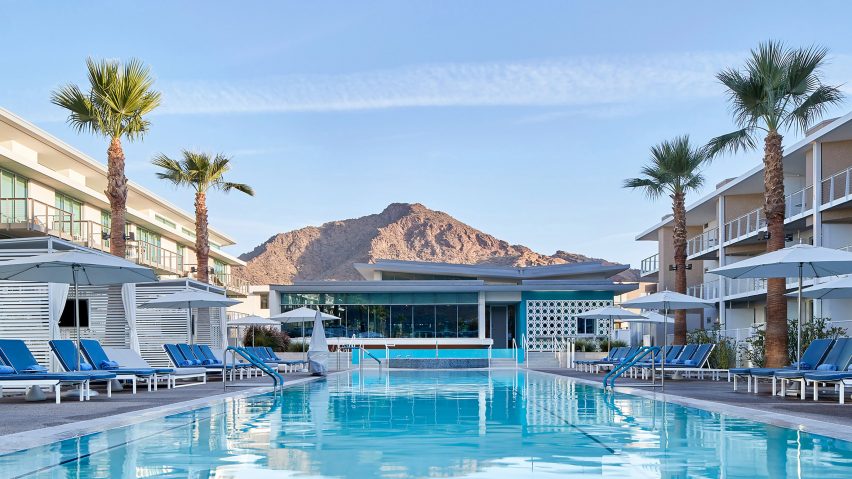New York City designer Mark Zeff has looked to 1960s desert-modern trends for the interiors of the rebuilt Mountain Shadows resort in Arizona.
The boutique hotel is located in Paradise Valley – a desirable alternative to Las Vegas for the 1950s Hollywood elite, which is still home to copious luxury resorts, spas and golf destinations.
Mountain Shadows owners commissioned Zeff's eponymous design firm to complete the interior of the two-storey property, after it was entirely rebuilt to its original mid-century plans.
Zeff used his personal affinity for this era and penchant for monochrome spaces to come up with an aesthetic that puts a contemporary spin on modernism.
"We really wanted the resort to blend into the environment," the designer told Dezeen. "With desert modern style, the landscape is part of the experience and architecture is almost secondary. That also applies to the interiors."
The layout of the resort comprises a linear volume containing the public spaces, and perpendicular wings containing guest rooms that extend back towards the rising topography.
A swimming pool and sunbathing area sits between two accommodation blocks, capped by the fitness suite. Grassy outdoor spaces around the property can be used for events like corporate parties and weddings.
In the lobby, the focal point is an expansive four-by-six-metre window – which Zeff describes as a "movie screen" – that looks out to Camelback Mountain.
The interiors are intended to disappear into the background with an uncomplicated composition. Floors are stencilled concrete and walls are whitewashed, with notes of white lacquer and anodised bronze throughout.
Custom furniture was created for the public areas, paired with lighting from New York brand Apparatus.
A sunken living room off the lobby features a bronze hanging fireplace, upholstered banquette seating, and leather armchairs.
"This space really reminds me of the last scene of Diamonds Are Forever with James Bond," said Zeff, referring to the 1971 movie's filming location in Palm Springs' modernist Elrod House.
A similar simplicity extends to the guest rooms, which have concrete floors and ceilings, large windows, and grey walls.
Beds frames made of whitewashed ash wood were custom-designed to give a "1950s California vibe". Some suites have grey textured wood panelling on the walls.
Markzeff also designed the on-site restaurant, Hearth '61, which has an exhibition counter and two rooms: one for all-day dining and another for more formal sit-down service.
"It has carpeting, which we don't normally do, but there was so much concrete already that it just worked," Zeff said.
When the weather is pleasant, the restaurant's walls open up onto the pool deck, creating a fluid indoor-outdoor space.
Paradise Valley and surrounding resort towns in the Phoenix metropolitan area are enjoyed as year-round vacation destinations thanks to the desert climate. In nearby Scottsdale, another mid-century property Hotel Valley Ho was recently given an interior makeover, signalling a resurgence in the region's popularity with tourists.

